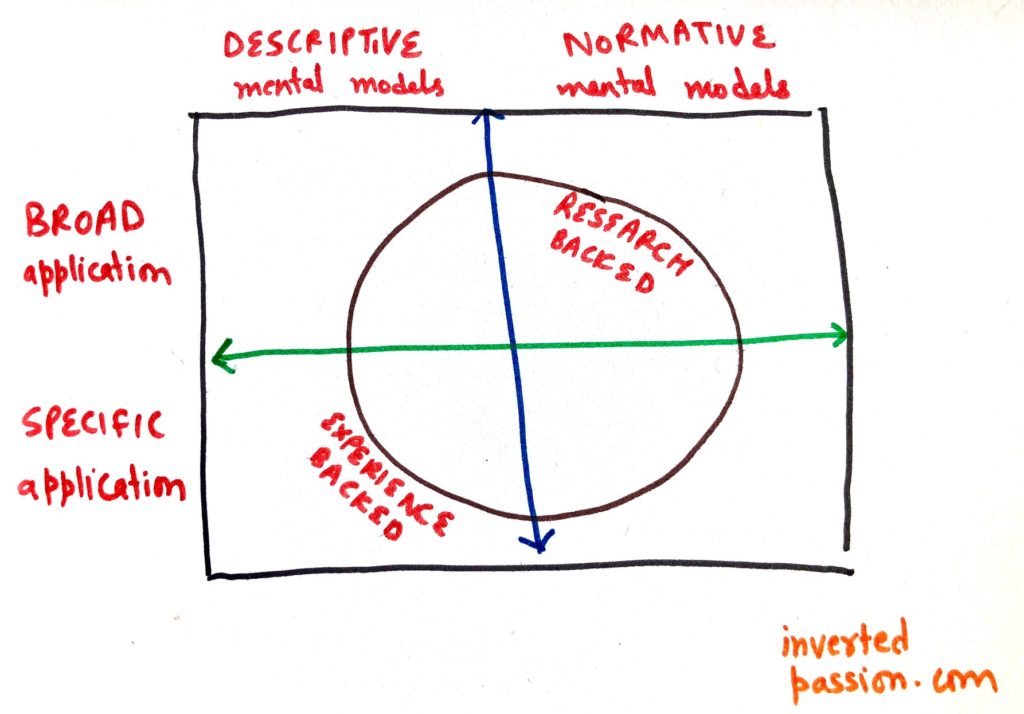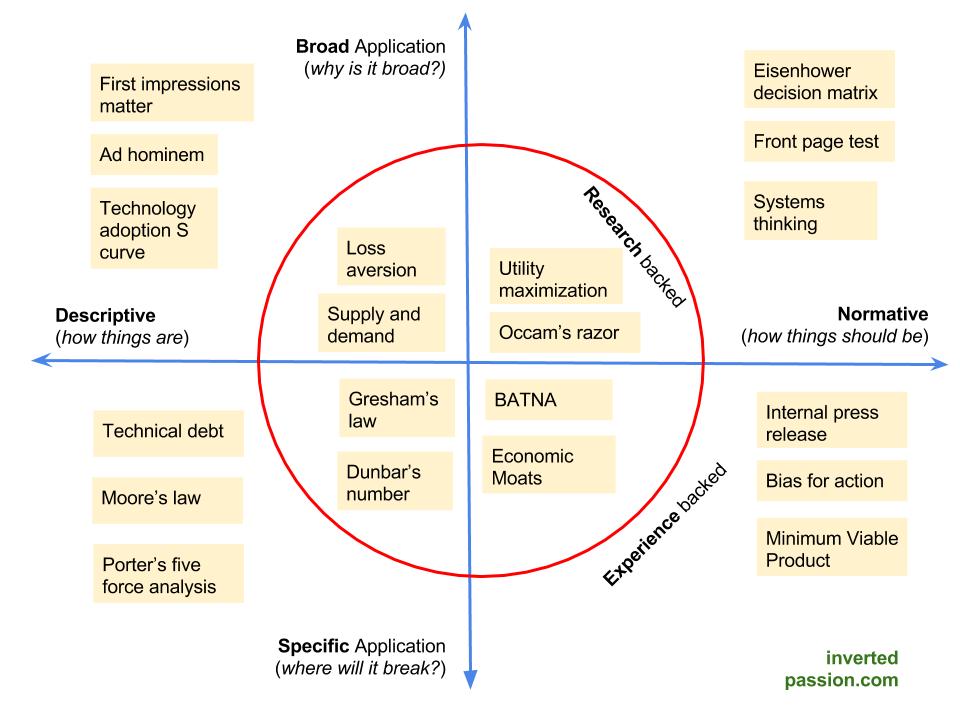Mental models are shortcuts that help you think better. One of the most famous ones is Pareto’s principle which says that for many phenomena, 80% of effects come from 20% of inputs. Management consultants love mental models: BCG matrix helps you with manage a portfolio of businesses, Porter’s five forces model helps you think about competition and Peter Principle helps you understand why organizations become full of incompetent managers.
Mental models are abstractions of reality. They’re like proverbs. For example, “Actions speaks louder than words” tells us that revealed preferences carry more information than stated preferences (something economists now take for granted). It’s a fun exercise to go through popular proverbs and decide if these old mental models are still useful in our interactions in the modern world.
But there lies the danger. It’s easy to misapply a mental model, and because it’s a mental shortcut, you usually won’t even catch the error until you get feedback from the real world that your choice of mental model was wrong. Imagine if you religiously start applying “Actions speaks louder than words” everywhere. Now if you are in a situation where the action by an individual carries a potential penalty but free speech allows you to speak anything without fear, it would make sense to actually save your actions until your words gather enough support from other people. (Read my previous post titled: Speaking your mind is a public service).
In this case, the proverb trips you up because details matter. One tiny detail is usually the difference between success or failure. I’ve made the mistake of misapplying mental models. For a long time throughout my 20s, I rigorously applied the mental model of rationality in many of my interactions. I thought customers calculated cost and benefits rationally, but they do not. I thought people act in accordance with their stated preferences (or previous promises), but they do not. Mental models get so entrenched that you start seeing the world through their lens. So, after a decade of misapplication, only recently I had the epiphany that everyone is surrounded by cognitive biases that prevent them from acting rationally.
Mental model about mental models
My misapplication of the rationality doesn’t make it useless. It’s just that I was applying it everywhere indiscriminately. This big error led me to think about mental models and how to use them. To clarify, by “meta mental model”, I mean a mental shortcut to help you choose and apply the right mental model, specific to your goals and surrounding context. The aim of any meta mental model should be to assist in choosing the right mental model and minimize chances of misapplication. Here goes my meta mental model.

I’ll explain specific terms.
- “Descriptive” v/s “Normative” classification: Descriptive mental models tell us how things are while “normative” make recommendations by telling us how things should be. This difference is important because either you’re using a mental model to understand what’s happening or to help you decide what you should do in a situation. For example, rationality is a good normative mental model, while prospect theory is a good descriptive mental model.
- “Broad application” v/s “Specific application” classification: Broad mental models can be applied to more than one type of phenomena. Specific mental models can be applied to only one specific type of phenomenon. For example, Pareto’s principle (the 80/20 rule) is seen in phenomena as wide as income, crime, and sports while Porter’s five forces analysis is specific to situations where business competes in an open, free market. Misapplication of Porter’s five forces can be dangerous.
- “Research backed” vs “Experience backed”: I find it useful to classify mental models that are vetted by peer-reviewed research vs the ones that come out of experience or anecdotes. Mental models such as getting 100 people to love you is clearly not backed by research. But the mental model that groups of 150+ people cannot be cohesive is clearly backed by research. I’m usually much more comfortable applying research backed mental models than anecdotal (people’s experience is context-dependent and while expressing a mental model, people may not be able to give entire context or you may misunderstand. For example, in what cases getting to 100 people to love you can backfire? Why just 100? At what cost?)
How to use the meta mental model?
Whenever you come across a mental model (which could be in form of advice, framework, diagram, research result, or anecdote), first classify it as either descriptive or normative. (If it’s both or you are not sure, see how it’s popularly used by other people). Ask yourself:
Does the mental model tell you how things are or does it tell you how things should be?,
Next, consider under what conditions should that mental model be applied. Remember it’s not about the number of instances of problems, the number of types of problems. If the mental model is broadly applied, ask what underlying reasons make it applicable to wide range of phenomena? (In case of Pareto’s principle, it’s found everywhere because power law is found in many places.) If it’s specific (like globalization leads to specialization), think of cases where the mental model breaks. (Assuming globalization is happening, under what cases would generalization would actually be beneficial? Can you find any examples of generalization thriving in this world?)
Finally, and this is the part that takes effort, go to Google Scholar and find out whether the mental model has any backing in research. Peer review process isn’t perfect, but it does a better job of vetting truths than people’s experiences or gut feeling. Of course, lack of evidence doesn’t mean that experience backed mental models are useless. It’s just that while analyzing experience based mental models (as ship early, ship often), you should be more critical.
Classifying mental models
Now that we have a meta mental model, let’s have fun applying it to a few famous mental models (my classification obviously is not comprehensive, it’s a demonstration).

My sources for mental models on the image above were these three excellent blog posts: Mental Models: The Best Way to Make Intelligent Decisions (113 Models Explained) by Farnam Street, Mental Models I Find Repeatedly Useful by Gabriel (founder of DuckDuckGo) and Mental models by Defmarco. I highly recommend going through these posts and classifying the mental models you like.
What is your favorite mental model?
Now that you’ve read the article, I have a question for you.
What is your favorite mental model and how do you use it?
I'll RT useful mental models for everyone's benefit.
— Paras Chopra (@paraschopra) January 23, 2018
Please share your favorite mental models (and how you use them) by replying to the tweet above (+ check out other readers’ favorite mental models).
Join 200k followers
Follow @paraschopra